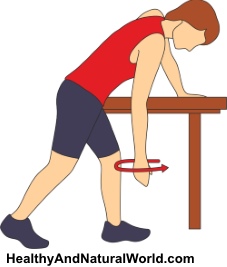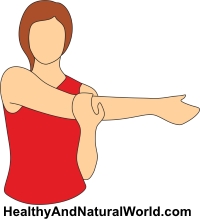Frozen Shoulder: Symptoms and Treatments (Including at Home Exercises)

Frozen shoulder, also known as Adhesive capsulitis (AC), is a painful condition of the shoulder persisting more than 3 months. This inflammatory and painful shoulder condition is accompanied by a gradual progressive stiffness and significant restriction of range of motion (usually external rotation). However, some people may develop frozen shoulder symptoms suddenly. Complete recovery could be extremely slow and may even take up to 2 to 3 years.
Read on to find out how to prevent and treat frozen shoulders, including what exercises you can do to at home to heal a frozen shoulder (illustrations included).
What is a Frozen Shoulder (Adhesive Capsulitis) ?
Frozen shoulder is a painful condition that affects the ligaments of the shoulder joint which are encased in a sac known as the articular shoulder capsule. The shoulder, like the hip, forms a ball and socket joint that allows for movement in a range of different directions.
As the capsule swells up it forms scar tissue and the shoulder becomes stiff. This results in pain and restricted mobility in that shoulder.
While the majority of sufferers will only be impacted in one shoulder, a significant minority (up to 20%) have the condition in both shoulders. Frozen shoulder is a distinct condition from arthritis which can affect other joints, whereas frozen shoulder refers specifically to the shoulder joint. If you are also suffering from arthritis read my post about the common vitamin deficiency that can trigger arthritis pain.
Signs and Symptoms of a Frozen Shoulder
Frozen shoulder typically develops gradually over a period of months, and symptoms are often easily dismissed at first before becoming very painful. The problem will usually manifest in three distinct stages.
1. Shoulder Stiffness and Pain: most people will notice their shoulder becoming increasingly stiff. As the stiffness progresses it becomes difficult to move the shoulder and any attempt to do so generates pain. This shoulder pain is often much worse when sleeping making it difficult to sleep and causing an increase in stress levels. This stage can last for up to 9 months.
2. Shoulder Freeze: the shoulder stiffness increases and the range of movement is severely limited. Some sufferers will notice the pain levels get a little less intense during this stage but for others they do not diminish. This stage can last for up to 12 months.
3. Thaw: the shoulder starts to improve slowly. Pain levels will start to decrease but will, occasionally, flare up. The best case scenario is that this stage will last about 5 months but it can take years to thaw the shoulder and many people never quite regain their former full range of motion.
During the worst stages of a frozen shoulder it might be very difficult to carry out a number of ordinary, everyday activities such as cooking or getting dressed. It could even impact on your ability to drive.
Frozen Shoulder – Causes and Risk Factors
Nobody really knows what exactly causes a frozen shoulder.
According to doctors, risk factors include having had an injury or surgery on the affected shoulder.
Diabetics or other people suffering from a chronic heart condition are also more likely to develop frozen shoulder, and a previous stroke is also a risk factor (get familiar with these early signs of stroke, and learn how to reduce your risk for stroke).
Other chronic diseases may also contribute to having frozen shoulder, such as an overactive or underactive thyroid so make sure you are aware of the 13 warning signs of a thyroid disorder.
People aged over 40 seem more prone to developing frozen shoulder and the condition is more likely to occur in women, particularly after the menopause, than men.
Treatment Options for Frozen Shoulder
There are a number of different treatment options that can help to heal a frozen shoulder. The treatment will often depend on the stage of frozen shoulder.
Hot/cold treatment: alternating the application of hot and cold packs can help to reduce some of the pain and swelling that comes with frozen shoulder and increase blood circulation in the area. Try and repeat the application a few times each day for best effect.
Painkillers: painkillers can provide relief in the early, painful, stages of frozen shoulder. Ibuprofen (Advil) is one of the most popular NSAIDs (non-steroidal anti-inflammatory drugs), and can help relieve swelling in addition to pain. But if you prefer a natural alternative to high doses of painkiller over long periods of time, you can try some of these 15 natural and effective alternatives to Ibuprofen.
Eat foods rich in Omega 3 fatty acids and other anti-inflammatories: Omega 3 fatty acids are known to have anti-inflammatory properties and those suffering from arthritis or other related joint conditions such as frozen shoulder are advised to increase their consumption. Fish oil and seeds such as flax seeds are a useful source. Green tea is also known to have anti-inflammatory properties.
Exercise: even though your shoulder is likely to be stiff, it is important to maintain movement, and stretching exercises can help with this (see the exercises at the end of the article). If you have suffered from a previous shoulder injury, you can reduce your chances of developing frozen shoulder by performing preventative stretching exercises.
Physical Therapy: treatment by a physiotherapist is likely to combine exercise, massage and hot/cold treatments under the supervision of a professional. For many sufferers these treatments can be replicated at home once they have been shown what to do through a few sessions.
TENS treatment: some people find relief through the use of a TENS machine (transcutaneous electrical nerve stimulation) which uses small pads to send electrical impulses through the body. TENS machines (like this one and this one) are relatively freely available for purchase or hire but you will need advice on the correct placement of the pads in order to ensure it has the best effect.
Corticosteroid injections: these injections can be used to help relieve pain and inflammation and give more movement in the shoulder. However, repeated corticosteroid injections are not recommended. They are a mask for the pain, not a cure, and become less effective with each application.
Surgery: if you are unable to resolve the pain and mobilize your shoulder using the techniques outlined above, you may need to consider surgery. Your doctor can help you decide if this is a necessary course of action for you. Options include manipulating he shoulder under general anesthetic or the removal of scar tissue via an endoscope (shoulder arthroscopy).
Generally speaking, the sooner you start to seek treatment for your frozen shoulder the less severe it is likely to be, and the less time it will take to get back to normal.
Exercises for Frozen Shoulder to Do At Home
Before starting these exercises, always warm up your shoulder first. The best way to do that is by taking a warm shower or bath for 10 to 15 minutes, or you can use a heating pad.
Pendulum stretch
Slightly lean over while your affected arm hang down. Relax your arm, and swing it in small circles. Make 10-15 circles in each direction (clockwise and then anti clockwise) once a day.
When your shoulder symptoms improve over time, increase the diameter of your swing, but don’t force it. If you feel you can do more than that, hold a light weight (1-2 kg) in the affected arm.
Towel stretch
Hold a towel behind your back in horizontal position. Pull the towel with your good arm so you pull and stretch the affected arm upwards. Repeat 10-20 times once a day.
Finger Walk
Face a wall a short distance away. Touch the wall with the fingertips of the affected arm at waist level while your elbow slightly bent. Slowly walk your fingers up the wall until your arm is raised as far as you comfortably can. When doing it don’t use your shoulder muscles. Only your fingers should do the work. Then slowly lower the affected arm and repeat 10-20 times a day.
Cross-Body Reach
You can do the exercise while you sit or stand. Lift the affected arm at the elbow with your good arm. Then bring the affected arm up and across your body while performing a gentle pressure to stretch the affected shoulder. Hold for 10-15 seconds and repeat 10-15 times a day.
Overhead Reach
Lie down on the floor or a bed and lift the affected arm overhead with the good arm at the elbow area. Place a gentle pressure with your good arm so you feel the stretch in the affected arm. Hold for 10-15 seconds and repeat 10-15 times a day.
Outward and Inward Rotations
For this exercise you will need a rubber exercise band.
Hold the band between your hands while your elbows are at 90 degree angle close to the sides of your body (see illustration). Pull the lower part of the affected arm outward few centimeters and hold for a few seconds. Repeat 10-15 times per day.
You can also use the band to do inward rotation – In this case you need to stand next to a closed door, and place one end of the band around the doorknob (make sure that its sturdy so that you wouldn’t break it).
Hold the other end of the band with the affected arm while holding your elbow at a 90-degree angle. Pull the band toward your body few centimeters and hold for a few seconds. Repeat 10 to 15 times per day.
Read my other related articles:
- Trapezius Strain: Causes, Symptoms, and Effective Home Remedies to Relieve Pain
- Shoulder Blade Pain: Possible Causes and Home Treatments
- How to Treat Stiff Neck In One Minute (or Less)
(2) https://www.ncbi.nlm.nih.gov/books/NBK482162/
(3) http://www.nhs.uk/Conditions/Frozen-shoulder/Pages/Symptoms.aspx
(4) http://www.webmd.com/diet/arthritis-guide
(5) http://www.health.harvard.edu/shoulders/stretching-exercises-frozen-shoulder






